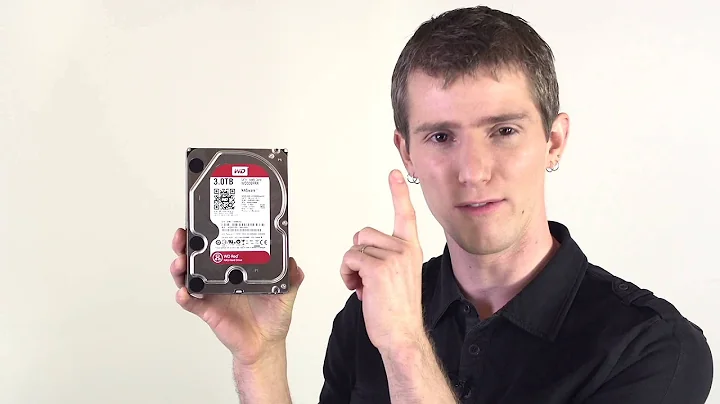In RAID what is better: fewer larger drives or more smaller drives?
Solution 1
When having the choice, go with more smaller drives instead a few large drives. This has different reasons:
- You can stripe reads and writes over more drives, leading to a speed increase
- Rebuilding smaller drives takes much less time.
- Very fast (15K SAS) drives will not be available with larger capacities
- Random reads could be handled by more heads, leading to a speed increase for applications requiring many small random reads.
Beware though that depending on your total capacity, a RAID5 could be considered unsafe, as encountering an URE while reconstructing a failed drive might become very likely.
Also, consider that using only two drives either gives you no redundancy or no speed increase, depending on your selected RAID type.
Solution 2
IMHO this question can not be answered correctly with the information provided. Prior to evaluating which RAID to implement one needs to have a specificition of the use. A RAID 5 implementation will satisify some requirements and fail to satisify others, as will other RAID implementations.
Layout all your requirements, performance, read write ratios, budgetg, etc and then decide or ask which implemention will suit your needs.
There are many WHITE papers on the web which describe the best use of each raid type.
Solution 3
I support SvenW's answer, but there are some drawbacks to consider about using smaller drives.
- The number of disk slots may be constrained so using smaller drives may limit total capacity and future upgrade options.
- More drives use more power and create more heat, vibration and noise, potentially reducing overall reliability.
Also, with the advent of SSDs, there is a school of thought that you can combine the capacity benefits of large disks with the performance benefits of solid-state disk, reducing the need for small high-performance disks. See my answer about cache devices in ZFS.
Solution 4
I would prefer RAID 5 there since you lose less space, and I consider the performance better. With 2x1TB RAID 1, you lose a full terabyte. With the RAID 5, you lose only 500GB.
That said, each has its own advantages.
RAID 1 advantages: All the data is redundant. If one disk fails, you do not have any performance degradation. Easy to understand.
RAID 1 disadvantages Lose more space. Does not perform as well as RAID 5. Has to write everything to both disks...no performance increase on writes.
RAID 5 performance is better for reads, which is good for database applications. Since you asked specifically about this, better at random read operations and writes since it can read/write from/to multiple disks, however this is also mitigated by having to update the parity information for each write, so the benefits are not as great as with reads. RAID 1 also can read from both disks, but limited to just two. These advantages can be increased by adding more disks. Easier to add more space if you run low.
RAID 5 disadvantages Performance degradation with the loss of a disk RAID has to be rebuilt when one fails and is then replaced.
There are surely more reasons that can be argued, but these are the main ones.
Related videos on Youtube
Ben
Updated on September 18, 2022Comments
-
Ben almost 2 years
I'm looking to building a RAID, and ran into a thought.
what is better, fewer larger drives (1 TB x 3), or more smaller drives (500 GB x 6).
I was looking at specifically a RAID 5 or similar. Is there a difference to things like data integrity, random read/writes, etc.
EDIT: I'm sorry, I mis-spoke, I was looking at only RAID 5 (and forgot that it has a minimum of 3 drives).
-
Ward - Reinstate Monica about 13 yearsHomework? This is the sort of design vs. budget vs. other constraints that a sysadmin needs to be able to figure out.
-
Ben about 13 yearsHm, being told to do my homework, as I'm doing it. Odd.
-
Mascarpone over 12 yearsWhat are you going to use this for? Server? How much reliability is important? SAS or SATA?
-
-
KCotreau about 13 yearsJust one final point: Although no one solution is perfect for everyone, you have to look at how much more popular RAID 5 has been with IT professionals over RAID 1.
-
Ben about 13 yearsVery well put, but I was looking at specifically the difference between large/few and small/many drives with a RAID 5. I misspoke, see the edited post
-
John Gardeniers about 13 yearsAnother factor to consider is that, all else being equal, smaller capacity drives tend to be more reliable.
-
KCotreau about 13 yearsNot totally correct. Two drives do give you a speed increase during reads.
-
KCotreau about 13 yearsOK. Then depending on the specific device and how many bays it has, and how much money the organization has, I would say the following...generally: If you have a large organization with unlimited money, a lot of small drives has more performance benefit, usually a major factor to such an organization. For a smaller organization, which may gain more data, but not have a lot of money to replace drives or servers, I would go with larger drives, leaving room in the extra bays to grow. I have had companies struggle with money when they ran out of space.
-
Naman Bansal about 13 years@KCotreau: For both RAID1 and RAID5, read performance scales with the number of disks. RAID1 uses more disks per capacity so for a given capacity, RAID1 has better read performance. RAID1 can normally be extended to RAID1+0 to add capacity. Main drawback of RAID5 is the R-M-W penalty for writing small IOs, which means there are physically 2 read and 2 write IOs for every logical IO. This means higher latency (important for database redo logs) and lower total IOPS. A battery-backed write cache can mask this performance penalty.
-
KCotreau about 13 years@Tom Shaw, "RAID1 has better read performance"?? Well since RAID 1 tops out at two disks, and RAID 5 can go well beyond three, if you want performance, a RAID 5 with many disks is the way to go. In general, your statement is incorrect. webhostingresourcekit.com/305.html
-
Naman Bansal about 13 years@KCotreau: It's technically true that RAID 1 tops out at 2 disks, but you're being pedantic. As I explained in the very next sentence, RAID 1 can be extended to RAID1+0; this is a standard feature in volume managers and storage arrays, which often just continue to call it "RAID 1" for simplicity.




